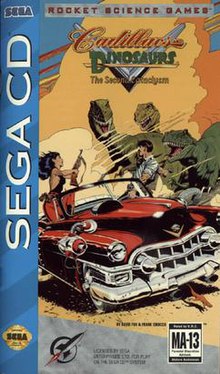Reception
In 1997, Jeff Sengstack of NewMedia wrote that Cadillacs and Dinosaurs "bombed miserably". Its sales by that point were below 20,000 units. [7] According to PC Data, which tracked computer game sales in the United States, Cadillacs and Dinosaurs and Loadstar sold under 8,000 copies combined by 1996. [8]
The game received generally mediocre reviews. Mike Weigand of Electronic Gaming Monthly commented on the game that "the graphics are quite good, but the overall theme of the game isn't very thrilling". [5] Scary Larry of GamePro agreed that the game was dull, remarking "there's not much else to do here but shoot and steer", and disagreed on the graphics, citing muddy colors and a lack of detail. [9] Next Generation saw a somewhat more positive review for the game. It said the game was technically impressive for its fluid animation and near-absence of load times, and though it criticized the lack of variety in the levels, it concluded: "However, on balance, it's smooth, fast and exciting, and what more could you ask for?" [6]
This page is based on this
Wikipedia article Text is available under the
CC BY-SA 4.0 license; additional terms may apply.
Images, videos and audio are available under their respective licenses.
